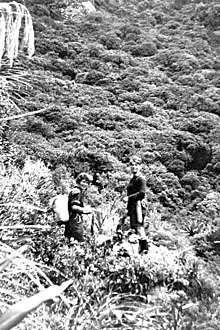Festuca luciarum
| Festuca luciarum | |
|---|---|

| |
| Holotype from the Auckland War Memorial Museum Herbarium | |
| Scientific classification | |
| Kingdom: | Plantae |
| Clade: | Tracheophytes |
| Clade: | Angiosperms |
| Clade: | Monocots |
| Clade: | Commelinids |
| Order: | Poales |
| Family: | Poaceae |
| Subfamily: | Pooideae |
| Genus: | Festuca |
| Species: | F. luciarum
|
| Binomial name | |
| Festuca luciarum | |
Festuca luciarum is a species of grass in the family Poaceae. It is endemic to New Zealand, found in the eastern North Island at higher altitudes.
Taxonomy and naming
[edit]
The species was first formally described in 1998 by Henry Connor, based on specimens collected by botanists Lucy Cranwell and Lucy Moore from Maungapohatu in Te Urewera in 1932.[2][3] Connor named the species after both Cranwell and Moore.[4]
The species is closely related to the species Festuca coxii, Festuca multinodis and Festuca ultramafica, which form the Neozeylandic clade II of Loliinae grasses.[5][6]
Description
[edit]F. luciarum is a tall stoloniferous grass with long shoots that have dark violet inflorescences.[2] There are morphological differences between different members based on which geographically separated area they are found in.[2]
Habitat and range
[edit]The species is endemic to New Zealand,[7] found in the inland areas of the eastern North Island, at an elevation of between 900–1,500 m (3,000–4,900 ft).[2]
References
[edit]- ^ "Festuca luciarum Connor". New Zealand Threat Classification System. Retrieved 6 September 2024.
- ^ a b c d Connor, H. E. (September 1998). "Festuca (Poeae: Gramineae) in New Zealand I. Indigenous Taxa". New Zealand Journal of Botany. 36 (3): 329–367. doi:10.1080/0028825X.1998.9512574. ISSN 0028-825X. Wikidata Q130242302.
- ^ "Festuca luciarum". Auckland War Memorial Museum. Retrieved 6 September 2024.
- ^ Young, Maureen; Cameron, Ewen (2014). "Plants named for our "two Lucies". An occasional paper in the series "Plants named for ABS members"" (PDF). Auckland Botanical Society Journal. 69 (2): 178–179. ISSN 0113-4132. Wikidata Q124313556.
- ^ Heenan, PB; Mitchell, AD; de Lange, PJ; Keeling, J; Paterson, AM (2010). "Late-Cenozoic origin and diversification of Chatham Islands endemic plant species revealed by analyses of DNA sequence data". New Zealand Journal of Botany. 48 (2): 83–136. doi:10.1080/0028825X.2010.494337. ISSN 0028-825X. Wikidata Q130242398.
- ^ Luis A Inda; José Gabriel Segarra-Moragues; Jochen Müller; Paul M Peterson; Pilar Catalán (5 December 2007). "Dated historical biogeography of the temperate Loliinae (Poaceae, Pooideae) grasses in the northern and southern hemispheres". Molecular Phylogenetics and Evolution. 46 (3): 932–957. doi:10.1016/J.YMPEV.2007.11.022. ISSN 1055-7903. PMID 18226932. Wikidata Q48075292.
- ^ "Codium cranwelliae". New Zealand Plant Conservation Network. Retrieved 5 September 2024.

